Tokonoma Album 002: Koi Fish Shooting up a Waterfall, Takasago, etc
Contents
Tokonoma & Kakejiku Scroll: 3 Koi Fish Shooting up a Waterfall
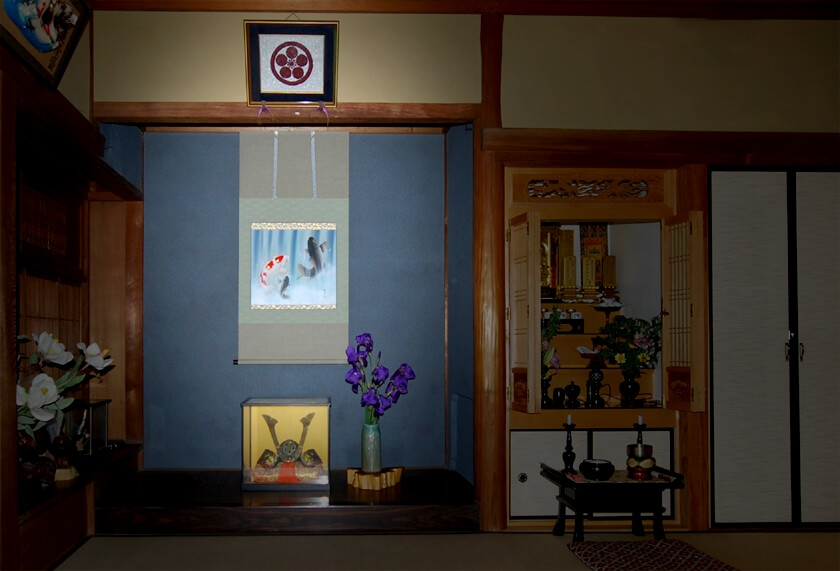
The Japanese have a custom of holding a variety of events praying for the healthy growth of boys, on the day of Tango-no-sekku, and May 5 is a national holiday, called “Children’s Day.” In a few regions, it is celebrated on June 5th, following the old lunar calendar.
In Japan, there was a ritual called “Satsuki-imi” (literally, accursed May), where all the men went out of the house, and only women stayed inside to wash the impurities away, and purify themselves before rice planting. This custom was connected to “tango,” which came from China.
In the Imperial Palace, people wearing a Japanese iris in their hair got together at the “Butokuden” (a palace building) and were granted a “Kusudama” (literally, a ball of medicine made of herbs with a decoration added) by the emperor. A record from the Nara period described these events in the imperial court.
The word for the Japanese iris was pronounced the same as the word for martial spirit (both were pronounced “shoubu”), and the shape of the leaves of the Japanese iris reminds people of swords. Therefore, tango was determined as the “sekku” for boys and people prayed for the healthy growth of boys during the Kamakura period.
The typical way to celebrate tango-no-sekku is to display armor, a helmet, a sword, a doll warrior, or “gogatsu-ningyou” doll (literally, doll of May) modeled after Kintarou (a famous brave boy in a nursery tale) on a tiered stand in a room, and to fly “Koi-nobori” (carp streamers) on a pole in the front yard. Displaying armor symbolizes protecting the boys. The custom of displaying koi-nobori originates in the Chinese tradition, and it is meant to pray for the success in a boy’s life.
The kakejiku which is displayed in this event can be describeds as follows:
The kakejiku of an iris painting.
The kakejiku of a “musha” (an armoured warrior) painting.
The kakejiku of a carp shooting up a waterfall.
It is said in Chinese history that a lot of fish tried to swim up a waterfall called “Ryuumon” in the rapids of the Yellow River, but only the carp succeeded and thus became dragons.
The kakejiku of a tiger or a dragon painting.
Their grand strength is believed to wards off evil spirits.
Tokonoma & Kakejiku Scroll: Takasago (Nice Old Couple)
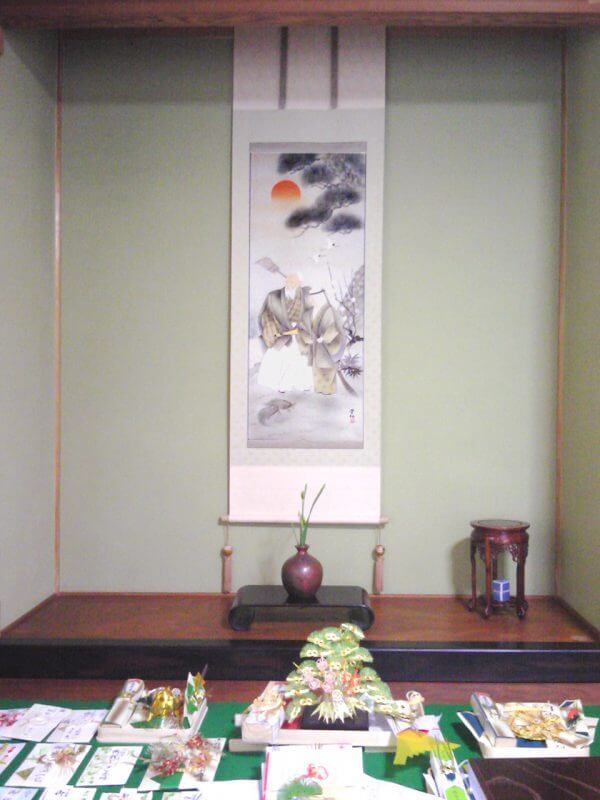
According to the Takasago Shrine in Takasago City, Hyougo Prefecture, there have been “Aioi-no-Matsu” (twin pines: a Japanese red pine and Japanese black pine that share their roots) ever since the Shinto shrine was established. A pair of trees called “Jou” (old man) and “Uba” (old woman) – a Japanese form of Darby and Joan – bearing the legend, “We kami reside in these trees to show the world the way of marital virtue,” stand within the shrine. This is why a Takasago painting is often displayed on an auspicious occasion.
Takasago generally means of an old man and woman.
Tokonoma & Kakejiku Scroll: Landscape Painting in Sumi Ink
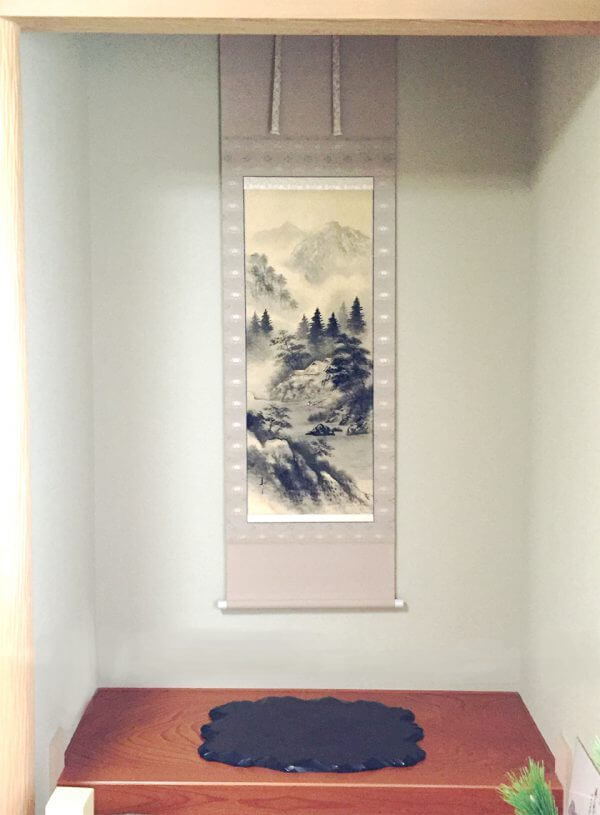
The landscape, often called “sansui” (literally mountain and water), is one of the subjects of the usual kakejiku.
“Suiboku-ga” (ink painting), the art of painting in just one color using “sumi” (Japanese ink), is not only for painting lines, but also for showing gradation through contrasting ink density and lighting.
The landscape painting with sumi is called a “suiboku-sansui.”
Tokonoma & Kakejiku Scroll: Saigoku Pilgrimage
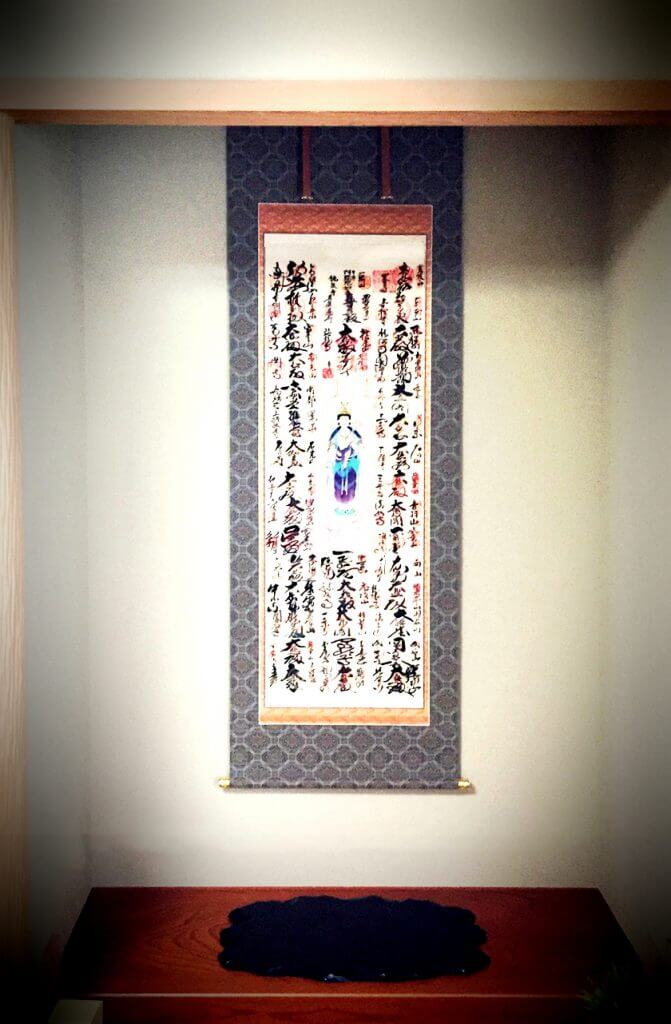
“Saigoku-Sanjūsan-kasho” is a pilgrimage of thirty-three Buddhist temples throughout the Kansai region of Japan. The pilgrimage route of the Saigoku Sanjūsankasho includes, as additional holy places, three more temples associated with the founder of the pilgrimage, Saint Tokudō, and the Cloistered Emperor Kazan who revitalized it. The principal image in each temple is Kannon-Bosatsu; however, there is some variation among the images and the powers they possess.
Pilgrims record their progress with a prayer book called “Noukyou-chou,” which the staff of each temple marks with red stamps and Japanese calligraphy, indicating the temple number, the temple name and the specific name of the Kannon image. Some pilgrims receive the stamps and calligraphy on plain silk, which will be mounted on a kakejiku (hanging scroll) by a kakejiku craftsman “hyougushi” like us. The kakejiku, which is called “saigoku-sanjuusan-kasho-shūinjiku,” is very popular in Japan. It is sometimes used in Buddhist memorial services.
The above kakejiku was mounted with Shin Buddhist style.
Tokonoma & Kakejiku Scroll: Amaterasu Oomikami Calligraphic Work
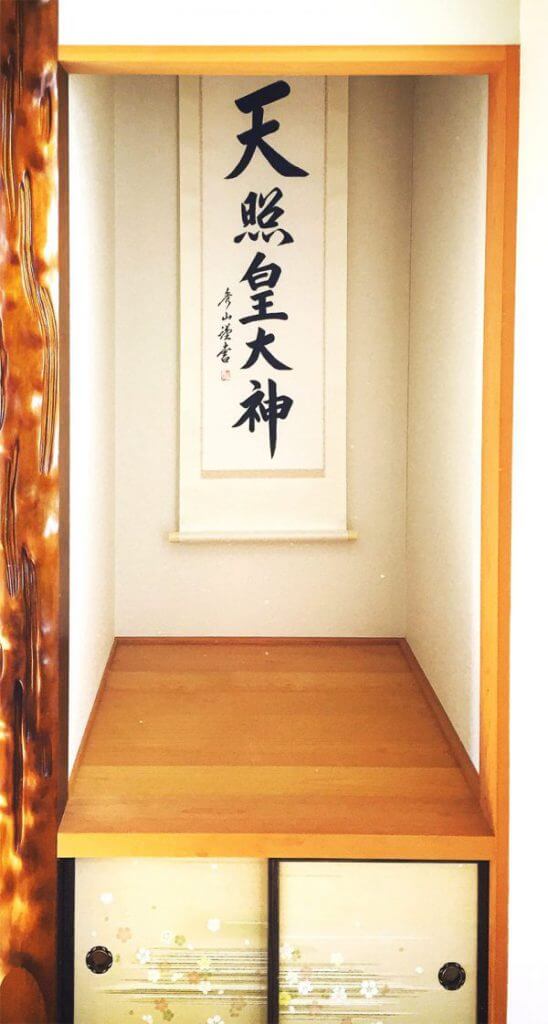
The sun has, since ancient times, been worshipped around the world and many religions have developed out of sun worshipping traditions. For example, “Amaterasu Oomikami,” the top god in Japanese mythology, is the sun god.
A “kakejiku” (hanging scroll), on which “Tenshoukoutaijin”(Amaterasu Oomikami) is written, is often displayed in “tokonoma” (alcove) for the safety of the family, a state of perfect health, a good harvest, and so on.

